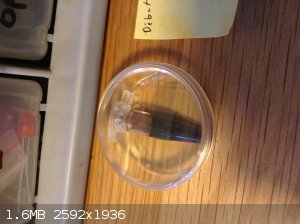hexago
Harmless

Posts: 2
Registered: 31-5-2016
Member Is Offline
Mood: No Mood
|
|
mystery stinking compound
Hey,
I recently made a reaction with ammoniac, sulfure and a nail polish remover containing acetone. This gave me three times the same result: after a few
days, the liquid starts to become orange and then completely black.
Knowing that sulfur chemistry may be dangerous I tried to open the very smallest vial i had (which was filled with that product) for a few seconds and
it stinks like crazy...
I have looked it up online but i can't find any clue on what this is.
thanks for your help
PS: i have posted a picture of the first day and of the last day of the reaction.
 
|
|
|
mayko
International Hazard
    
Posts: 1218
Registered: 17-1-2013
Location: Carrboro, NC
Member Is Offline
Mood: anomalous (Euclid class)
|
|
Sulfur can dissolve in concentrated sodium hydroxide solutions; perhaps it will slowly dissolve in ammonia? The reaction of basic dissolved sulfur and
acetone has also been described. Here's some older threads which might interest you:
http://www.sciencemadness.org/talk/viewthread.php?tid=23236
http://www.sciencemadness.org/talk/viewthread.php?tid=23750
http://www.sciencemadness.org/talk/viewthread.php?tid=23860
al-khemie is not a terrorist organization
"Chemicals, chemicals... I need chemicals!" - George Hayduke
"Wubbalubba dub-dub!" - Rick Sanchez
|
|
|
hexago
Harmless

Posts: 2
Registered: 31-5-2016
Member Is Offline
Mood: No Mood
|
|
thanks for the help
I just begin to understand how vast this forum is 
good day
|
|
|
Eddygp
National Hazard
   
Posts: 858
Registered: 31-3-2012
Location: University of York, UK
Member Is Offline
Mood: Organometallic
|
|
The discussion was never really closed in those threads, but I would go for the enolate ion of acetone attacking dissolved sulfur and then the RS-
deprotonating water giving OH- (regenerated).
It's a matter of checking whether the OH- is acting as a catalyst. If it isn't, this is most probably not the mechanism.
there may be bugs in gfind
[ˌɛdidʒiˈpiː] IPA pronunciation for my Username |
|
|
CuReUS
National Hazard
   
Posts: 928
Registered: 9-9-2014
Member Is Offline
Mood: No Mood
|
|
You have replicated in a scientific way,an age-old recipe to make stink bombs
the S reacted with NH3 to form NH4SH,which further reacted with more S to form ammonium polysulphide,which is orange yellow
| Quote: | Adding sulfur will cause the ammonium sulfide solution to turn yellow-orange as ammonium polysulfide [(NH4)2Sx] is formed. The polysulfide is also
used in mineral analyses, though not as often as the regular sulfide.
Sometimes ammonium sulfide solution will turn yellow-orange even when no sulfur has been added. This happens via oxidation by atmospheric oxygen;
the result is also polysulfide. |
http://www.crscientific.com/nh4sulfide.html
making a stink bomb using NH3 and matchheads
https://www.youtube.com/watch?v=Zk4UAhsBL1A
nice video on preparation and properties on ammonium sulphide- https://www.youtube.com/watch?v=8IHt_H2j7H0
|
|
|
woelen
Super Administrator
        
Posts: 8027
Registered: 20-8-2005
Location: Netherlands
Member Is Offline
Mood: interested
|
|
@CuReUS: I think there is much more to this than sulphur reacting with ammonia. There is acetone in the mix and this gives a deep brown compound under
these conditions. Ammonium sulfide is colorless or pale yellow if it contains some polysulfide as well.
I once did a similar experiment, which does not need days to form the brown compound, but only minutes. I added sulphur to acetone. Some sulphur
dissolves, most remains undissolved under the acetone. I added highly concentrated solution of NaOH. When this is shaken, then the liquid turns dark
brown and a bad smell appears.
With ammonia the reaction is much slower, because of much less strength of the basic solution. It is hydroxide, acetone and sulphur which together
give the interesting reaction. I do not know, however, what the brown material is.
|
|
|
Eddygp
National Hazard
   
Posts: 858
Registered: 31-3-2012
Location: University of York, UK
Member Is Offline
Mood: Organometallic
|
|
This is what leads me to think about a possible enolate ion intermediate.
It would lead to sulfanylpropanone (sorry for my possibly mistaken nomenclature). Otherwise a hemithioacetal-like compound, or thioacetal?
there may be bugs in gfind
[ˌɛdidʒiˈpiː] IPA pronunciation for my Username |
|
|
zed
International Hazard
    
Posts: 2284
Registered: 6-9-2008
Location: Great State of Jefferson, City of Portland
Member Is Offline
Mood: Semi-repentant Sith Lord
|
|
Well.....you haven't supplied the additional component of heat, but we might be looking at the Willgerodt Reaction. In which case, there would be a
Thioamide present in the product.
|
|
|
CuReUS
National Hazard
   
Posts: 928
Registered: 9-9-2014
Member Is Offline
Mood: No Mood
|
|
Zed,you are partly right, see this
http://pubs.acs.org/doi/abs/10.1021/ja01211a083
|
|
|
MeshPL
Hazard to Others
  
Posts: 329
Registered: 20-4-2015
Location: Universe
Member Is Offline
Mood: No Mood
|
|
I think that Willgerodt requires a much higher temperature, since even with piridine catalyst temperature required is around 160C. I may be wrong
though. For reaction with ammonia a pressure reactor is needed due to so high temperature requirements and volataility of ammonia.
I think that we may also observe formation of some kind of acetone and acetone-ammonia condensation products, which alone are brown, but not so
smelly. Triacetone amine is one of the main products of such reactions.
|
|
|